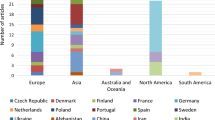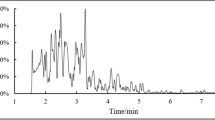Abstract
Two fluorimetric HPLC methods are described for the quantification of naphthols, phenanthrols and 1-hydroxypyrene (1-OHP) in urine specimens obtained from male Wistar rats exposed to naphthalene, phenanthrene and pyrene. The polycyclic aromatic hydrocarbons (PAHs) were given intraperitoneally, either alone (1.0 mmol/kg body weight) or as an equimolar mixture (0.33 mmol/kg), using the same dosages for repeated treatments on week 1 and week 2. Between these treatments, PAH-metabolizing activities encoded by aryl hydrocarbon (Ah) receptor-controlled genes were induced in the rats with β-naphthoflavone (βNF). Chromatographic separation of five phenanthrols (1-, 2-, 3-, 4-, and 9-isomers) was accomplished using two different RP C-18 columns. Despite selective detection (programmable wavelengths), the quantification limits in the urine ranged widely: 1-OHP (0.18 µg/l) <phenanthrols (0.34–0.45 µg/l) <2-naphthol (1.5 µg/l) <1-naphthol (4 µg/l). The relative standard deviation of the methods was good, as also was the reproducibility. The molar fraction of the dose excreted in 24-h urine as naphthols (≤4.0%), phenanthrols (≤1.1%), and 1-OHP (≤2.4%) was low. Urinary disposition increased differentially in βNF-induced rats: naphthols, 9-phenanthrol (1- to-2-fold); 2-, 3-, and 4-phenanthrols (4- to 5-fold); 1-phenanthrol and 1-OHP (over 11-fold). The OH-metabolites were analyzed before and after enzymatic hydrolysis (β-glucuronidase/arylsulfatase). The percentage excreted as a free phenol in urine varied for 1-OHP (2–11%), 1-naphthol (36–51%), 2-naphthol (59–65%), and the phenanthrols (29–94%). 1-Naphthyl- and 1-pyrenyl β-d-glucuronide served as measures for the completeness of enzymatic hydrolysis. Characteristic differences observed in the urinary disposition of naphthalene, phenanthrene, and pyrene are described, as well as important factors (dose, metabolic capacity, relative urinary output) associated with biomarker validation. This intervention study clarifies intraindividual variation in PAH metabolism and provides useful information for the development of new methods applicable in the biomonitoring of PAH exposure in humans.




Similar content being viewed by others
References
ACGIH (American Conference of Govermental Industrial Hygienists) (2001) Documentation of the threshold limit values for chemical substances, 7th ed. ACGIH, Cincinnati
Andreoli R, Manini P, Bergamaschi E, Mutti A, Franchini I, Niessen WM (1999) Determination of naphthalene metabolites in human urine by liquid chromatography-mass spectrometry with electrospray ionization. J Chromatogr A 847:9–17
Angerer J, Mannschreck C, Gundel J (1997a) Occupational exposure to polycyclic aromatic hydrocarbons in a graphite-electrode producing plant: biological monitoring of 1-hydroxypyrene and monohydroxylated metabolites of phenanthrene. Int Arch Occup Environ Health 69:323–331
Angerer J, Mannschreck C, Gundel J (1997b) Biological monitoring and biochemical effect monitoring of exposure to polycyclic aromatic hydrocarbons (a review). Int Arch Occup Environ Health 70:365–377
Bakke J, Struble C, Gustafsson JA, Gustafsson B (1985) Catabolism of premercapturic acid pathway metabolites of naphthalene to naphthols and methylthio-containing metabolites in rats. Proc Natl Acad Sci U S A 82:668–671
Bock KW (1994) Aryl hydrocarbon or dioxin receptor: biologic and toxic responses. Rev Physiol Biochem Pharmacol 125:1–42
Bock KW, van Ackeren G, Lorch F, Birke FW (1976) Metabolism of naphthalene to naphthalene dihydrodiol glucuronide in isolated hepatocytes and in liver microsomes. Biochem Pharmacol 25:2351–2356
Boos KS, Lintelmann J, Kettrup A (1992) Coupled-column high-performance liquid chromatographic method for the determination of 1-hydroxypyrene in urine of subjects exposed to polycyclic aromatic hydrocarbons. J Chromatogr 600:189–194
Bouchard M, Viau C (1999) Urinary 1-hydroxypyrene as a biomarker of exposure to polycyclic aromatic hydrocarbons: biological monitoring strategies and methodology for determining biological exposure indices for various work environments. Biomarkers 4:159–187
Boyland E, Sims P (1964) Metabolism of polycyclic compounds. 23. The metabolism of pyrene in rats and rabbits. Biochem J 90:391–398
Buening MK, Levin W, Karle JM, Yagi H, Jerina DM, Conney AH (1979) Tumorigenicity of bay-region epoxides and other derivatives of chrysene and phenanthrene in newborn mice. Cancer Res 39:5063–5068
Chae YH, Marcus CB, Ho DK, Cassady JM, Baird WM (1991) Effects of synthetic and naturally occurring flavonoids on benzo[a]pyrene metabolism by hepatic microsomes prepared from rats treated with cytochrome P-450 inducers. Cancer Lett 60:15–24
Conney AH (1982) Induction of microsomal enzymes by foreign chemicals and carcinogenesis by polycyclic aromatic hydrocarbons: G. H. A. Clowes Memorial Lecture. Cancer Res 42:4875–4917
Corner EDS, Young L (1954) Biochemical studies of toxic agents 7. The metabolism of naphthalene in animals of different species. Biochem J 58:647–655
Dor F, Dab W, Empereur-Bissonnet P, Zmirou D (1999) Validity of biomarkers in environmental health studies: the case of PAHs and benzene. Crit Rev Toxicol 29:129–168
Elovaara E, Heikkila P, Pyy L, Mutanen P, Riihimaki V (1995) Significance of dermal and respiratory uptake in creosote workers: exposure to polycyclic aromatic hydrocarbons and urinary excretion of 1-hydroxypyrene. Occup Environ Med 52:196–203
Elovaara E, Luukkanen L, Hesso A, Vainio H (1996) 1-Pyrenol and its glucuronide as urinary biomarkers of PAH exposure. In: Aitio A, et al. (eds) Abstracts: International Symposium on Biological Monitoring in Occupational and Environmental Health. Finnish Institute of Occupational Health (ISBN 951-802-136-8), Helsinki, Finland, pp 179–180
Grimmer G, Jacob J, Dettbarn G, Naujack KW (1997) Determination of urinary metabolites of polycyclic aromatic hydrocarbons (PAH) for the risk assessment of PAH-exposed workers. Int Arch Occup Environ Health 69:231–239
Hansen AM, Poulsen OM, Christensen JM, Hansen SH (1992) Determination of alpha-naphthol in human urine by high-performance liquid chromatography. J Liquid Chromatogr 15:479–499
Harper KH (1957) The metabolism of pyrene. Br J Cancer 11:499–507
Heikkilä PR, Luotamo M, Riihimaki V (1997) Urinary 1-naphthol excretion in the assessment of exposure to creosote in an impregnation facility. Scand J Work Environ Health 23:199–205
IARC (International Agency for Research on Cancer) (1983) Polynuclear aromatic compounds. Part 1. Chemical, environmental and experimental data. IARC Monographs on the evaluation of the carcinogenic risk of chemicals to humans, vol 32. IARC Press, Lyon
Jacob J, Grimmer G, Raab G, Schmoldt A (1982a) The metabolism of pyrene by rat liver microsomes and the influence of various mono-oxygenase inducers. Xenobiotica 12:45–53
Jacob J, Schmoldt A, Grimmer G (1982b) Influence of monooxygenase inducers on the metabolic profile of phenanthrene in rat liver microsomes. Toxicology 25:333–343
Jerina DM, Daly JW, Witkop B, Zaltzman-Nirenberg P, Udenfriend S (1970) 1,2-naphthalene oxide as an intermediate in the microsomal hydroxylation of naphthalene. Biochemistry 9:147–156
Jerina DM, Sayer JM, Agarwal SK, Yagi H, Levin W, Wood AW, Conney AH, Pruess-Schwartz D, Baird WM, Pigott MA, et al. (1986) Reactivity and tumorigenicity of bay-region diol epoxides derived from polycyclic aromatic hydrocarbons. Adv Exp Med Biol 197:11–30
Jongeneelen FJ (1997) Methods for routine biological monitoring of carcinogenic PAH-mixtures. Sci Total Environ 199:141–149
Jongeneelen FJ (2001) Benchmark guideline for urinary 1-hydroxypyrene as biomarker of occupational exposure to polycyclic aromatic hydrocarbons. Ann Occup Hyg 45:3–13
Jongeneelen FJ, Anzion RB, Henderson PT (1987) Determination of hydroxylated metabolites of polycyclic aromatic hydrocarbons in urine. J Chromatogr 413:227–232
Kandaswami C, Kumar S, Rutkowski JP, Sikka HC (1988) Comparative metabolism of phenanthrene and benzo[f]quinoline by rat liver microsomes. Cancer Lett 43:197–205
Kilanowicz A, Czerski B, Sapota A (1999) The disposition and metabolism of naphthalene in rats. Int J Occup Med Environ Health 12:209–219
Kuljukka T, Vaaranrinta R, Veidebaum T, Sorsa M, Peltonen K (1996) Exposure to PAH compounds among cokery workers in the oil shale industry. Environ Health Perspect 104 Suppl 3:539–541
Lauwerys RR, Hoet P (2001) Biological monitoring of exposure to organic substances. In: Lauwerys RR, Hoet P (eds) Industrial Chemical Exposure: Guidelines for Biological Monitoring (3rd ed). CRC Press LLC, Lewis Publishers, London, pp 183–583
Levin JO (1995) First international workshop on hydroxypyrene as a biomarker for PAH exposure in man—summary and conclusions. Sci Total Environ 163:164–168
Lindros KO, Oinonen T, Kettunen E, Sippel H, Muro-Lupori C, Koivusalo M (1998) Aryl hydrocarbon receptor-associated genes in rat liver: regional coinduction of aldehyde dehydrogenase 3 and glutathione transferase Ya. Biochem Pharmacol 55:413–421
Lintelmann J, Hellemann C, Kettrup A (1994) Coupled-column high-performance liquid chromatographic method for the determination of four metabolites of polycyclic aromatic hydrocarbons, 1-, 4- and 9-hydroxyphenanthrene and 1-hydroxypyrene, in urine. J Chromatogr B Biomed Appl 660:67–73
Luukkanen L, Elovaara E, Lautala P, Taskinen J, Vainio H (1997) Characterization of 1-hydroxypyrene as a novel marker substrate of 3-methylcholanthrene-inducible phenol UDP-glucuronosyltransferase(s). Pharmacol Toxicol 80:152–158
Luukkanen L, Mikkola J, Forsman T, Taavitsainen P, Taskinen J, Elovaara E (2001) Glucuronidation of 1-hydroxypyrene by human liver microsomes and human UDP-glucuronosyltransferases UGT1A6, UGT1A7, and UGT1A9: development of a high-sensitivity glucuronidation assay for human tissue. Drug Metab Dispos 29:1096–1101
McKillop D, Case DE (1991) Mutagenicity, carcinogenicity and toxicity of beta-naphthoflavone, a potent inducer of P448. Biochem Pharmacol 41:1–7
Nordqvist M, Thakker DR, Vyas KP, Yagi H, Levin W, Ryan DE, Thomas PE, Conney AH, Jerina DM (1981) Metabolism of chrysene and phenanthrene to bay-region diol epoxides by rat liver enzymes. Mol Pharmacol 19:168–178
Noto H, Halgard K, Daae HL, Bentsen RK, Eduard W (1996) Comparative study of an inhalable and a total dust sampler for personal sampling of dust and polycyclic aromatic hydrocarbons in the gas and particulate phase. Analyst 121:1191–1196
Redegeld FA, Hofman GA, Noordhoek J (1988) Conjugative clearance of 1-naphthol and disposition of its glucuronide and sulfate conjugates in the isolated perfused rat kidney. J Pharmacol Exp Ther 244:263–267
Sims P (1959) Metabolism of polycyclic compounds 14. The conversion of naphthalene into compounds related to trans-1:2-dihydro-1:2-dihydroxynaphthalene by rabbits. Biochem J 73:389–395
Singh R, Tucek M, Maxa K, Tenglerova J, Weyand EH (1995) A rapid and simple method for the analysis of 1-hydroxypyrene glucuronide: a potential biomarker for polycyclic aromatic hydrocarbon exposure. Carcinogenesis 16:2909–2915
Smith CJ, Huang W, Walcott CJ, Turner W, Grainger J, Patterson DG, Jr. (2002) Quantification of monohydroxy-PAH metabolites in urine by solid-phase extraction with isotope dilution-GC-MS. Anal Bioanal Chem 372:216–220
Turkall RM, Skowronski GA, Kadry AM, Abdel-Rahman MS (1994) A comparative study of the kinetics and bioavailability of pure and soil-adsorbed naphthalene in dermally exposed male rats. Arch Environ Contam Toxicol 26:504–509
Vainio H, Elovaara E, Luukkanen L, Anttila S, Ulmanen I, Fourneul-Gigleux S, Ouzzine M, Pillot T, Magdalou J (1995) Expression and co-induction of CYP1A1 and UGT1*6 in human lungs. Eur J Drug Metabol Pharmacokin 20:47–48
Viau C, Bouchard M, Carrier G, Brunet R, Krishnan K (1999) The toxicokinetics of pyrene and its metabolites in rats. Toxicol Lett 108:201–207
Weems HB, Mushtaq M, Fu PP, Yang SK (1986) Direct separation of non-K-region mono-ol and diol enantiomers of phenanthrene, benz[a]anthracene, and chrysene by high-performance liquid chromatography with chiral stationary phases. J Chromatogr 371:211–225
WHO (World Health Organization) (1996) Polycyclic aromatic hydrocarbons: 1-Hydroxypyrene in urine. In: Biological Monitoring of Chemical Exposure in the Workplace, Guidelines, vol 2. WHO, Geneva
Yang M, Koga M, Katoh T, Kawamoto T (1999) A study for the proper application of urinary naphthols, new biomarkers for airborne polycyclic aromatic hydrocarbons. Arch Environ Contam Toxicol 36:99–108
Acknowledgements
We thank Ms Maria Pihlaja for valuable technical assistance, Dr Kaija Pekari for GC analysis of urinary naphthols, and Dr Pirjo Heikkilä for helpful co-operation. This work was conducted in association with the project BMH4-CT97-2621 supported by the Commission of the European Communities, and the Finnish Research Programme on Environmental Health (SYTTY) supported by the Academy of Finland and the Finnish Work Environment Fund.
Author information
Authors and Affiliations
Corresponding author
Rights and permissions
About this article
Cite this article
Elovaara, E., Väänänen, V. & Mikkola, J. Simultaneous analysis of naphthols, phenanthrols, and 1-hydroxypyrene in urine as biomarkers of polycyclic aromatic hydrocarbon exposure: intraindividual variance in the urinary metabolite excretion profiles caused by intervention with β-naphthoflavone induction in the rat. Arch Toxicol 77, 183–193 (2003). https://doi.org/10.1007/s00204-003-0436-0
Received:
Accepted:
Published:
Issue Date:
DOI: https://doi.org/10.1007/s00204-003-0436-0




